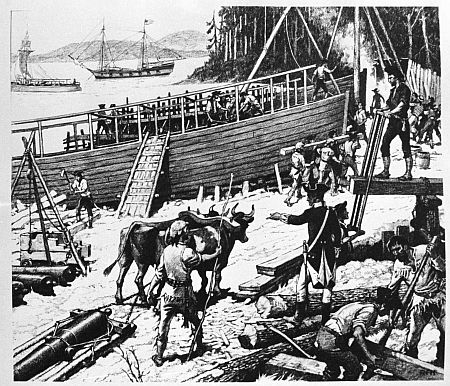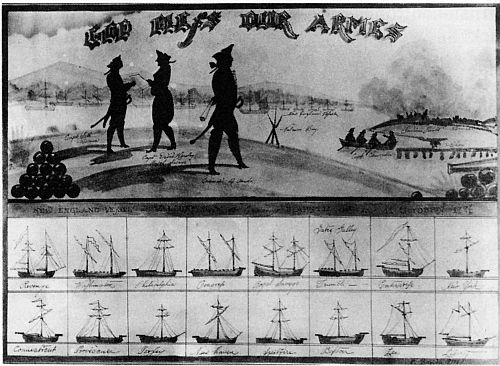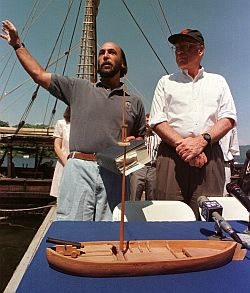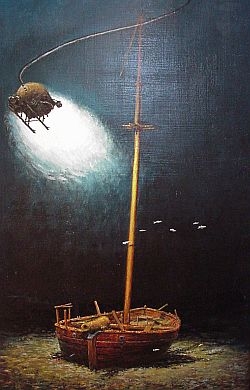
(HOST INTRO) Three hundred historic shipwrecks have been documented at the bottom of Lake Champlain. All this week VPR is taking a look at what sent five of them to the bottom and into the history books in our series, "History Under the Waves".
Today we start off with the gunboat Spitfire.
Click here for the History Under the Waves photo gallery
Built in 1776, it was part of Benedict Arnold’s first American naval fleet on the lake. Roughly fifty-four feet long and carrying heavy cannons, swivel guns and a compliment of forty-five men, it was designed to repel ships escorting the British army down the lake.
In late September, 1776, Arnold’s fleet of fifteen ships was patrolling the northern end of Lake Champlain, engaging in skirmishes with the British. He retreated south to Valcour Island, a location that permitted the fleet to escape bad weather and position itself for a possible engagement.

On the morning of October 11, the British fleet, moving south, passed Arnold’s ships which were anchored on the west side of Valcour without noticing them at first. Turning north after discovering the Americans, the British fleet engaged Arnold’s in what is now known as the Battle of Valcour Island. Art Cohn, Director of the Lake Champlain Maritime Museum describes the battle that led to the Spitfire’s sinking.
(ART COHN) All hell broke loose in terms of "They’re really here. We’ve got to get ready for this engagement.

The British had sailed around the outside of Valcour Island with a northerly wind so they had to actually beat back against the wind to engage Arnold. And that’s what probably gave his fleet the chance to survive that day. Because the British fleet which was larger, better armed and better sailors did engage in more than five hour, very close battles, broadside to broadside, a horrific engagement, loud, smoky, deafening.
You would have not seen very much, cause once your cannon started to fire you were pretty much enveloped in gun smoke for a good part of the day. And all the other boats would have almost created their own little smokescreen.
But you would have heard a constant, deafening roar of large cannon, smaller cannon, swivel guns and small arms.
The schooner Royal Savage was lost almost before the engagement ever really formally started. And it was the Royal Savage being set afire the night of October 11th that we think aided Arnold in this almost unbelievable, daring nighttime escape, where he was able to row and sail his fleet single file past the British blockade that had been set up specifically to stop him from doing just that.
 And it was on that retreat, in the middle of the night, that the gunboat Spitfire, leaking so badly from damage and its activities during the battle was forced to be abandoned and sent to the bottom of Lake Champlain, where we found it in 1997.
And it was on that retreat, in the middle of the night, that the gunboat Spitfire, leaking so badly from damage and its activities during the battle was forced to be abandoned and sent to the bottom of Lake Champlain, where we found it in 1997.
And we staged a verification dive. And sure enough, as we got to the bottom and went in the direction we thought the boat was, using our compasses, we came into contact with a Revolutionary War gunboat that hadn’t been seen since the early morning hours of October 12th, 1776.
And what we could see was, this boat was completely intact right up to the gunnel. It’s sitting upright just like it was sailing. The mast is still standing! And it’s still standing full height!
And then the great excitement of getting to the bow of the vessel and realizing that the large bow cannon was not only still with the boat, but it was in its exact firing position on its carriage, in its slide and was still trying to find somebody to shoot at. It was really quite remarkable.
These intact three dimensional vessels, the true shipwrecks have all the material culture of their time and moment. They are clues and evidence to the way society functioned in the past.
In a military ship that was operating during 1776, we really do get to study and try to understand the profound questions of the origin of the country. And that’s a privilege and an opportunity that I think we all feel very lucky to be around.
(HOST) Tomorrow in our series we’ll look at the steamboat Phoenix that met its fiery fate in 1819. You can find more information on this series and others in our Champlain400 coverage at VPR.net.
Originally broadcast July 27, 2009 as part of VPR’s Champlain 400 coverage.